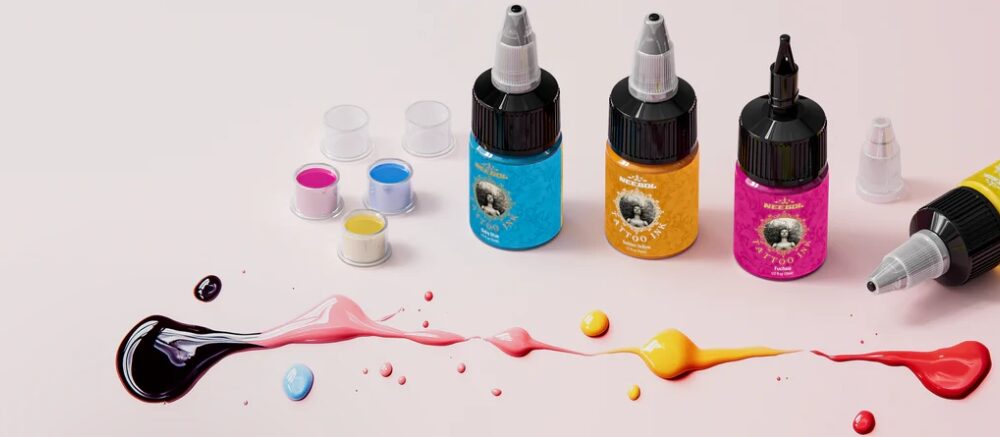What Makes Quality Tattoo Ink? A Deep Dive into Ingredients, Safety, and Color Retention

Tattooing is an art that combines skill, creativity, and the use of quality materials — and one of the most important materials is tattoo ink. Whether you’re a seasoned artist or a first-time enthusiast, understanding what makes tattoo ink high-quality can influence the final result and safety of your tattoo. This article will take you through the essential aspects of tattoo ink, including its ingredients, safety considerations, and how well the colors hold up over time.
The Basics: What is Tattoo Ink Made Of?
Tattoo ink is essentially a mixture of pigments and a carrier solution. The pigments provide the color, while the carrier ensures the pigment is evenly dispersed and easily applied to the skin.
Pigments: The Heart of Tattoo Ink
Pigments can be organic or inorganic compounds. They provide the rich, vibrant colors seen in tattoos. Some pigments are derived from natural sources, while others are synthetic.
- Organic pigments are carbon-based and tend to be brighter and more vibrant. For example, certain reds and blues fall into this category.
- Inorganic pigments are typically mineral-based, like iron oxides for blacks and browns, or titanium dioxide for white.
Carrier Solutions: The Ink’s Vehicle
The carrier solution is a liquid that suspends the pigment particles, allowing smooth application. Common carriers include:
- Distilled water – provides purity and reduces contamination risk.
- Alcohol (ethanol or isopropyl) – helps sterilize the ink and prevent microbial growth.
- Glycerin – adds moisture and improves the ink’s consistency.
- Witch hazel – sometimes used for soothing properties.
The right balance of these components impacts how well the ink flows through the tattoo needle and into the skin.
Why Does Ink Quality Matter?
Using low-quality tattoo ink can lead to several problems, including allergic reactions, infections, and premature fading. High-quality tattoo ink ensures better skin compatibility, richer color, and longevity.Safety Concerns with Tattoo Ink
Tattoo ink is injected directly into the dermis layer of the skin, which means safety is paramount. Several issues can arise from poor-quality or contaminated ink:
Allergic Reactions
Some pigments, especially reds and yellows, can cause allergic responses. These may manifest as itching, swelling, or even more severe dermatitis.
Toxic Ingredients
Certain inks contain heavy metals like lead, cadmium, or mercury, which can be harmful. Reputable manufacturers avoid these and adhere to safety regulations.
Contamination Risks
Non-sterile ink or poor packaging can introduce bacteria or fungi, leading to infections.
What to Look For in Quality Tattoo Ink
When selecting tattoo ink, artists and customers should consider:
1. FDA and Regulatory Approvals
Although tattoo ink isn’t fully regulated by the FDA in some countries, inks that comply with safety standards or have undergone rigorous testing are preferable.
2. Transparency of Ingredients
Manufacturers who list ingredients openly tend to be more trustworthy.
3. Sterility and Packaging
Single-use ink caps or sealed bottles minimize contamination risks.
4. Color Consistency and Pigment Concentration
High pigment concentration generally means better color saturation and longer-lasting tattoos.
5. Reviews from Professional Tattoo Artists
Feedback from industry professionals can provide real-world insight into performance and safety.
The Role of Color Retention in Tattoo Ink Quality
Even the most beautiful tattoo can lose its charm if the colors fade too quickly. Good tattoo ink is formulated to maintain vibrancy for years.
Factors Affecting Color Retention:
- Pigment type and quality: Organic pigments often offer brighter colors but may fade faster. Inorganic pigments tend to be more stable.
- Ink formulation: The carrier’s composition can affect how well pigment particles settle into the skin.
- Tattoo aftercare: Proper healing and protection from sunlight prolong color life.
- Tattoo placement and skin type: Areas exposed to friction or sunlight may fade faster.
How Does Tattoo Ink Interact with the Tattoo Gun Kit?
The application of tattoo ink depends on the equipment used, notably the tattoo gun kit. A well-made tattoo gun kit ensures smooth ink flow and precision in depositing pigment into the skin. Here’s how quality ink and a good gun kit work together:
- Consistent flow: High-quality ink paired with an efficient gun kit ensures that the needle deposits the pigment evenly.
- Reduced clogging: Ink that is well-formulated reduces needle clogging, allowing the artist to work faster and cleaner.
- Optimal penetration: The tattoo gun kit’s design allows the needle to deposit pigment at the right depth, helping color retention and minimizing skin damage.
Tips for Choosing the Right Tattoo Ink
- Do your research: Buy from reputable brands known for quality and safety.
- Ask your tattoo artist: Professionals have preferred inks based on their experience.
- Check for certifications: Some brands provide third-party lab testing results.
- Test for allergies: If possible, do a patch test before a full tattoo.
- Consider the tattoo’s purpose: Some inks are better suited for fine lines, others for bold colors.
Final Thoughts
Choosing quality tattoo ink is just as important as the artist’s skill or the design itself. Good ink ensures safety, vibrant color, and longevity. When paired with a reliable tattoo gun kit, the result is a beautiful, lasting work of art on the skin.
If you’re exploring your tattoo options, always prioritize quality over price when it comes to ink. Your skin deserves the best!

Source: What Makes Quality Tattoo Ink? A Deep Dive into Ingredients, Safety, and Color Retention



